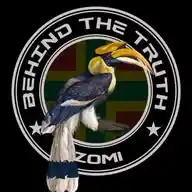
𝔹𝔼ℍ𝕀ℕ𝔻 𝕋ℍ𝔼 𝕋ℝ𝕌𝕋ℍ (𝔹𝕋𝕋)
January 22, 2025 at 08:32 AM
*Day 3: Chhinlung: Fact or Metaphor?*
_Every people's journey begins with a story, and for the Zomi, this story is intricately tied to Chhinlung—a place both real and imagined. _Chhinlung, often described as a mythical cave, is said to be the cradle of Zomi origins_. But is it merely a geographical location, or does it serve as a metaphor for unity and resilience? As with many myths, its value lies less in literal truth and more in its ability to connect, inspire, and unify.
The legend of Chhinlung is rich with ambiguity. Some Zomi oral traditions describe it as a physical cave, while others see it as a symbolic origin point. Vumson (1986) observes *Zo legend asserts that the Zo were originally from a cave called Chinnlung, which is given different locations by different clans*. The legend cannot be accepted as a fact because it contradicts known facts of how man originated. This ambiguity is not a weakness but a strength, allowing Chhinlung to embody both the tangible and the intangible.
_In Zomi tradition, Chhinlung is not just a point of emergence but a moment of transformation. It symbolizes a transition from obscurity to recognition, from isolation to interconnectedness_. As *Thangkhangin (1979) explains, the Zomi forefathers claimed that they were people from Chhinlung, which they described as a rock with a cavity*. From this rock emerged the ancestors of the Zomi, marking the beginning of their shared journey. This shared journey connects communities across time and space, emphasizing common origins even as external pressures have sought to divide.
The story of Chhinlung also reflects the Zomi's adaptability. Oral traditions recount different versions of the tale, each shaped by the community recounting it. This fluidity highlights the dynamic nature of Zomi's identity—one that evolves while retaining its core values. In this way, Chhinlung is less of a fixed point in history and more of a living narrative shaped by those who tell it.
But why does a mythical origin matter? Myths like Chhinlung offer more than an explanation of beginnings; they provide frameworks for understanding the present. As Vumson (1986) notes, *Legends such as Chhinlung serve as cultural touchstones, linking past struggles with present aspirations and reinforcing the bonds of kinship*. The truth of Chhinlung, lies not in its historical verifiability but in the values it embodies—resilience, unity, and transformation.
The story of Chhinlung invites us to question what it means to belong. _Is belonging tied to a place, or does it come from shared narratives and collective memory? For the Zomi, Chhinlung is both—a symbol of their deep connection to each other and their ability to adapt and endure_. As Thangkhangin (1979) beautifully encapsulates, *Zomi's journey from Chhinlung is less about geography and more about the transformation of the people—an evolution of spirit and identity*.
*Reflection* :
Could Chhinlung represent more than an origin? Perhaps it is a story of transformation, a reminder of how communities forge meaning from the chaos of history. _Tomorrow, we will explore the genealogies of the Zomi, tracing how stories like Chhinlung shaped their connections to the past and their understanding of identity._
*Quote to Highlight* :
"The Zomi's journey from Chhinlung is less about geography and more about the transformation of a people—an evolution of spirit and identity."
*Discussion Prompt* :
Do you see your personal or community history reflected in a story like Chhinlung? What does it tell you about your journey and identity?
*BTT*
🔴🟡🟢
https://whatsapp.com/channel/0029VaYCqe71yT229xZ6f42y
❤️
👍
😂
🤮
🐒
👌
💩
💯
😢
😮
50